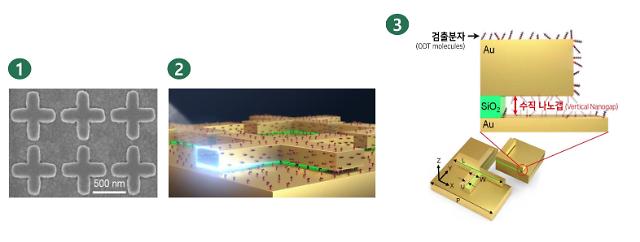
[Courtesy of KIMM]
SEOUL -- Researchers have developed a metamaterial that improves the sensitivity of infrared absorption spectroscopy more than 100 times. The special material can be used in the creation of ultra-sensitive infrared sensors for the detection of biomolecules and harmful substances. It is very affordable and easy to make.
A metamaterial is a synthetic material that is engineered to have a property that is not found in naturally occurring materials. The special material is normally made of microscopic-sized assemblies of multiple materials including metals and plastics arranged in repeating patterns. It is used to manipulate electromagnetic waves by blocking, absorbing, strengthening, or bending waves. Any form of light can be described as an electromagnetic wave.
Infrared spectroscopy is a test method used to verify the type of substances on a surface by radiating infrared light onto a material and calculating the strength of the reflected light. Each substance has its own unique light-absorbing characteristics so that researchers can recognize the types. However, if there is only a tiny trace of a substance, there is hardly any difference in the strength of the reflected light, making it harder to detect.
A joint study has been launched by the state-run Korea Institute of Machinery & Materials (KIMM) and the Ulsan National Institute of Science and Technology (UNIST) to develop a highly effective metamaterial that can be easily mass-produced for a low price. It was created using crisscross layers of nanoantennae in a metal-insulator-metal configuration to have vertical nano-sized gaps of a smaller size than the infrared wavelength. Each layer is 10-nanometer thick.
"The proposed metamaterial achieved a record-high difference of 36 percent in our demonstration on a monolayer with a thickness of 2.8 nanometers. This is the best record achieved to date among monolayer detection experiments," UNIST researcher Hwang In-yong said. Conventional metamaterials require expensive high-resolution lithography machines to produce microstructures on the material's surfaces, but KIMM's production stages involve affordable nanoimprint lithography and dry-etching processes to cut manufacturing costs.
Copyright ⓒ Aju Press All rights reserved.





View more comments